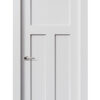Description
THE DOOR NAME ORIGIN – “SHAKER STYLE 3 CRAFT PANEL”
The design of this unapologetically beautiful interior door model was inspired by the aesthetic principles of the Shaker movement: just like all the other interior doors in this collection.
All in all, the Shaker style was New England’s response to the proliferation of neo- Baroque elements in all major civilized areas of the world where old-style Baroque had been ostensibly rejected as too feudal, too reminiscent of the absolute monarchy ideals, too shamelessly sumptuous to fit the ideas of democracy. In order to maintain even an illusion of equality, designers turned to Neoclassical ideas, using antiquity as their principal source of inspiration. However, the Industrial Revolution created a new aristocracy – that of businessmen and financiers – and their goal was to live “like kings.” New branches of Neoclassicism began to appear rapidly, and frank, in-your-face luxury was once again gaining traction. This ran contrary to the Shaker philosophy. To compensate, New England designers began to value simplicity above all – while preserving the overall elegance of their design.
History isn’t always fair. Upon the “Bourbon Restoration” in France, and Louis Philippe became the new King of that country. Well aware of the fact that extreme luxury irritated the King’s subjects in hard times, he ruled in an unpretentious fashion, avoiding the pomp and lavish spending of his predecessors. At first, he was much loved and called the “Citizen King” and the “bourgeois monarch”, but his popularity suffered as his government was perceived as increasingly conservative and monarchical. Under his management, the conditions of the working classes deteriorated, and the income gap widened considerably. Because of this, his name became synonymous with luxury, and two years after his abdication the newly elected President of the United States, Millard Fillmore, was dubbed “the American Louis Phillippe” merely because he was, supposedly, excessively fond of elegant clothes.
The Shakers’ idea that luxury is sinful was in keeping with some Nineteenth Century maximalist views, and, like so many of those, it was an overkill. In and of itself, luxury can’t be sinful. Displays of luxury, however, can be tactless in certain times and regions.
Every action produces a reaction, as one insightful scientist once said and when on to prove. The Shaker designers’ goal was to produce items that pleased the eye without being luxurious. The results exceeded all expectations: even during the Fillmore Administration, New England designs began to spread rapidly across the continent, and especially westward.
This particular interior door is not modeled on the Stonehenge, as some folks might assume (even though the idea is kind of cute). Rather, the two vertical and one horizontal panels would be reminiscent of the letter Pie, which is the ultimate symbol of the scientific approach to architecture. The circle may not be the simplest geometrical shape you can think of, but it is most certainly the most ubiquitous. An opening interior door’s edge describes a circle segment.
Ah, yes: this interior door does come with all the usual Almes Doors great features, such as the Italian-made 3D-adjustable concealed hinges, the soundless magnetic lock, and the automatic sweep. It has excellent sound-proofing and thermal insulation qualities. The former will ensure privacy, whilst the latter will work wonders with your electrical bill.
FINISH: PRIMED
The advantages of this approach – of this type of interior door finish – are fairly obvious. Pick a color, any color that suits your projects best. Mix and apply. Re- coat whenever you feel it is necessary to do so. Touch it up. It gives you, the proud owner of these interior doors, complete freedom of choice, and the significant savings, especially where it comes to bulk orders, can be a true source of joy.
As Kurt Vonnegut mentions in one of his novels (Bluebeard, unless I’m mistaken … check it out when you get a chance), the thrill of laying on colors is a large part of the artist’s professional satisfaction. In other words, a keen pleasure.
When back in the remote past visual arts became a field dominated by professionals rather than hobbyists, the main problem of “just laying on paint” became obvious: you can’t.
The medium of choice back then was egg tempera, a permanent, fast-drying substance consisting of colored pigments mixed with a water-soluble binder medium, usually glutinous material such as egg yolk. Portraits and ornaments were executed in this medium, and the wood panel was the surface of choice. One of tempera’s interesting features is that it is not as easily absorbed by wood as other mediums. Some sort of primer was necessary, of course, but pretty much any substance that dried evenly could be used.
The drawbacks of tempera, or pintura al temple, as the Spanish call it, only became obvious with the advent of the Renaissance, when the leading representatives of the trade turned to oil (and interior doors suddenly became a great deal less crude, but that’s a story for another day).










